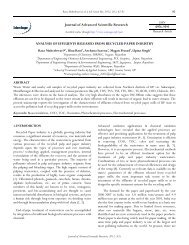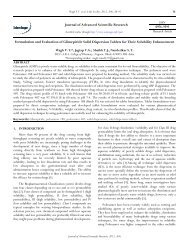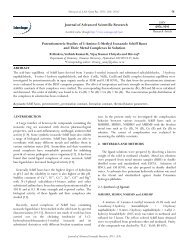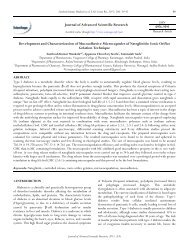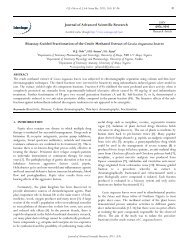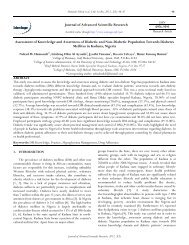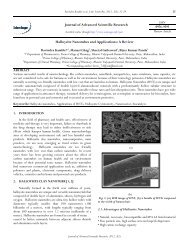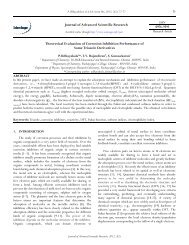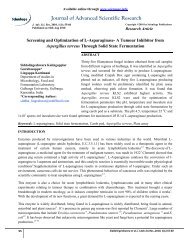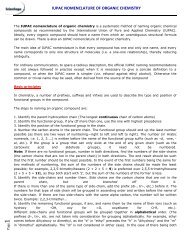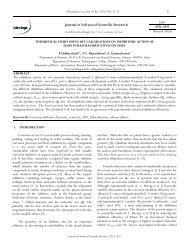Density Functional Theory Investigations for the ... - Sciensage.info
Density Functional Theory Investigations for the ... - Sciensage.info
Density Functional Theory Investigations for the ... - Sciensage.info
Create successful ePaper yourself
Turn your PDF publications into a flip-book with our unique Google optimized e-Paper software.
P. Udhayakala et al, J Adv Sci Res, 2012, 3(3): 67-74 67<br />
Journal of Advanced Scientific Research<br />
Available online through http://www.sciensage.<strong>info</strong>/jasr<br />
ISSN<br />
0976-9595<br />
Research Article<br />
<strong>Density</strong> <strong>Functional</strong> <strong>Theory</strong> <strong>Investigations</strong> <strong>for</strong> <strong>the</strong> adsorption of some Oxadiazole Derivatives<br />
on Mild Steel<br />
P. Udhayakala a* , T.V. Rajendiran b , S. Gunasekaran c<br />
a Department of Chemistry, Dr.MGR Educational and Research Institute, Chennai -600095, India.<br />
b Department of Chemistry, Pachaiyappa’s College, Chennai - 600 030, India.<br />
C Department of Physics, Spectrophysics Research Laboratory, Pachaiyappa’s College, Chennai- 600 030, India.<br />
*Corresponding author: udhayakala_kumar@yahoo.in<br />
ABSTRACT<br />
Two oxadiazole derivatives namely 2,5-bis(4-methylphenyl)-1,3,4-oxadiazole (Inh-1) and 2,5-bis(4-methoxyphenyl)-1,3,4-<br />
oxadiazole (Inh-II) were investigated as corrosion inhibitors <strong>for</strong> mild steel using density functional <strong>the</strong>ory (DFT) at B3LYP/6-<br />
31G(d,p) level. Quantum chemical parameters most relevant to <strong>the</strong>ir potential action as corrosion inhibitors such as E HOMO<br />
(highest occupied molecular orbital energy), E LUMO (lowest unoccupied molecular orbital energy), <strong>the</strong> energy gap(∆E), hardness<br />
(η), Softness(S), dipole moment(μ), electron affinity(A), ionization potential(I), <strong>the</strong> absolute electronegativity (χ), <strong>the</strong> fraction of<br />
electron transferred (ΔN), electrophilicity index(ω) and <strong>the</strong> back-donation(ΔE Back-donation ) have been calculated and discussed. The<br />
local reactivity has been analysed through <strong>the</strong> Fukui and condensed softness indices inorder to predict both <strong>the</strong> reactive centres and<br />
to know <strong>the</strong> possible sites of nucleophilic and electrophilic attacks. The <strong>the</strong>oretical conclusions were found to be consistent with <strong>the</strong><br />
experimental data reported.<br />
Keywords: Oxadiazoles, quantum chemical descriptors, reactivity, DFT, Fukui function, softness indices, electrophilicity index.<br />
1. INTRODUCTION<br />
The degradation of materials’ properties due to<br />
interactions with <strong>the</strong>ir environment is called Corrosion.<br />
Corrosion phenomena of mild steel exist widely in various<br />
industrial fields, resulting in huge economic losses and many<br />
potential safety questions [1, 2]. The study of corrosion<br />
processes and <strong>the</strong>ir inhibition by organic compounds is a very<br />
active field of research [3]. Organic compounds, which can<br />
donate electrons to unoccupied d orbital of metal surface to<br />
<strong>for</strong>m coordinate covalent bonds and can also accept free<br />
electrons from <strong>the</strong> metal surface by using <strong>the</strong>ir anti bonding<br />
orbital to <strong>for</strong>m feedback bonds, constitute excellent corrosion<br />
inhibitors. Over <strong>the</strong> years, considerable ef<strong>for</strong>ts have been<br />
deployed to find suitable corrosion inhibitors of organic origin<br />
in various corrosive media [4, 5]. It has been commonly<br />
recognized that organic inhibitor usually promotes <strong>for</strong>mation<br />
of a chelate on <strong>the</strong> metal surface, which includes <strong>the</strong> transfer of<br />
electrons from <strong>the</strong> organic compounds to metal, <strong>for</strong>ming<br />
coordinate covalent bond during such chemical adsorption<br />
process [6]. In this way, <strong>the</strong> metal acts as an electrophile,<br />
whereas <strong>the</strong> nucleophile centers of inhibitor molecule are<br />
normally hetero atoms with free electron pairs which are<br />
readily available <strong>for</strong> sharing, to <strong>for</strong>m a bond. Many efficient<br />
inhibitors are heterocyclic organic compounds consisting of a<br />
-system and / or oxygen, nitrogen, phosphorus or sulphur<br />
hetero atoms [7-9]. The planarity and <strong>the</strong> lone electron pairs<br />
in <strong>the</strong> hetero atoms are important features that determine <strong>the</strong><br />
adsorption of molecules on <strong>the</strong> metallic surface [10].<br />
The inhibition efficiency has been closely related to <strong>the</strong><br />
inhibitor adsorption abilities and <strong>the</strong> molecular properties <strong>for</strong><br />
different kinds of organic compounds [11-13]. The adsorption<br />
of <strong>the</strong>se compounds is influenced by <strong>the</strong> electronic structure of<br />
<strong>the</strong> inhibiting molecule [14] and also by <strong>the</strong> steric factors,<br />
aromaticity and electron density at <strong>the</strong> donor atoms [15]. Free<br />
electron pairs on hetero atoms or π electrons are readily<br />
available <strong>for</strong> sharing to <strong>for</strong>m a bond and act as nucleophile<br />
centres of inhibitor molecules and greatly facilitate <strong>the</strong><br />
adsorption process over <strong>the</strong> metal surface, whose atoms act as<br />
electrophiles [16]. The reactive ability of <strong>the</strong> inhibitor is<br />
closely linked to <strong>the</strong>ir frontier molecular orbital (FMO),<br />
including highest occupied molecular orbital, HOMO, and<br />
lowest unoccupied molecular orbital, LUMO, and <strong>the</strong> o<strong>the</strong>r<br />
parameters such as hardness and softness. Quantum chemical<br />
studies have been successfully per<strong>for</strong>med to link <strong>the</strong> corrosion<br />
inhibition efficiency with molecular orbital (MO) energy levels<br />
<strong>for</strong> some kinds of organic compounds [17, 18]. Recently <strong>the</strong><br />
effectiveness of an inhibitor molecule has been related to its<br />
spatial as well as electronic structure [19, 20].<br />
Journal of Advanced Scientific Research, 2012, 3(3)
M Lebrini et al. have studied <strong>the</strong> inhibiting effects of some<br />
oxadiazole derivatives on <strong>the</strong> corrosion of mild steel in<br />
perchloric acid solution [21]. Joseph Raj et al. have investigated<br />
<strong>the</strong> effect of some oxadiazole derivatives on <strong>the</strong> corrosion<br />
inhibition of brass in natural seawater [22]. A new class of<br />
corrosion inhibitors of mild steel in acidic media on <strong>the</strong><br />
substituted 1,3,4-oxadiazoles was studied by bentiss et al. [23].<br />
Although experimental work of M. Benabdellah, et al. [24]<br />
provide valuable in<strong>for</strong>mation on <strong>the</strong> corrosion inhibition<br />
efficiency of 2,5-Bis(4-methylphenyl)-1,3,4-oxadiazole (Inh-I)<br />
and 2,5-bis(4-methoxyphenyl)-1,3,4-oxadiazole (Inh-II), a<br />
deep understanding of <strong>the</strong> inhibition property remain unclear.<br />
To date, however, no study has been per<strong>for</strong>med to investigate<br />
<strong>the</strong> corrosion inhibition efficiency of Inh-II >Inh-I by using<br />
quantum chemical calculations. The aim of <strong>the</strong> present work is<br />
to correlate <strong>the</strong> clear relationship between <strong>the</strong> experimentally<br />
determined inhibition efficiencies with <strong>the</strong> quantum chemical<br />
parameters of <strong>the</strong> investigated inhibitors.<br />
The analyzed inhibitive properties are <strong>the</strong> molecular<br />
structure, <strong>the</strong> dipole moment, E HOMO , E LUMO , energy gap (ΔE),<br />
and those parameters that give valuable in<strong>for</strong>mation about <strong>the</strong><br />
reactive behavior: electronegativity (χ), global hardness (η)<br />
and <strong>the</strong> fraction of electrons transferred from <strong>the</strong> inhibitor<br />
molecule to <strong>the</strong> metallic atom (ΔN) and <strong>the</strong> back-donation<br />
(ΔE Back-donation ). The local reactivity has been analyzed by means<br />
of <strong>the</strong> Fukui indices, since <strong>the</strong>y indicate <strong>the</strong> reactive regions, in<br />
<strong>the</strong> <strong>for</strong>m of <strong>the</strong> nucleophilic and electrophilic behavior of each<br />
atom in <strong>the</strong> molecule. Results obtained showed that <strong>the</strong><br />
inhibition efficiency of Inh-II > Inh-1. It is well correlated with<br />
<strong>the</strong> experimental results. From <strong>the</strong> calculations we have<br />
explained which adsorption site is favoured to bind to <strong>the</strong><br />
metal surface.<br />
2. MATERIAL AND METHODS<br />
2.1. Quantum-chemical calculation<br />
P. Udhayakala et al, J Adv Sci Res, 2012, 3(3): 67-74 68<br />
is considered a very useful technique to probe <strong>the</strong><br />
inhibitor/surface interaction as well as to analyze <strong>the</strong><br />
experimental data. The results of <strong>the</strong> geometry optimization of<br />
<strong>the</strong> compounds Inh-I and Inh-II are presented in Figure 1.<br />
2,5-bis(4-methylphenyl)-1,3,4-oxadiazole (Inh-I)<br />
2,5-bis(4-methoxyphenyl)-1,3,4-oxadiazole (Inh-II)<br />
Inh-I<br />
Among quantum chemical methods <strong>for</strong> evaluation of<br />
corrosion inhibitors, density functional <strong>the</strong>ory (DFT) has<br />
shown significant promise and appears to be adequate <strong>for</strong><br />
pointing out <strong>the</strong> changes in electronic structure responsible <strong>for</strong><br />
inhibitory action [25]. In order to explore <strong>the</strong> <strong>the</strong>oreticalexperimental<br />
consistency, quantum chemical calculations were<br />
per<strong>for</strong>med with complete geometry optimizations using<br />
standard Gaussian-03 software package [26]. Geometry<br />
optimization were carried out by B3LYP functional at <strong>the</strong> 6-<br />
31G (d,p) basis set [27]. This basis set provided accurate<br />
geometry and electronic properties of a wide range of organic<br />
compounds [28]. Recently, <strong>Density</strong> functional <strong>the</strong>ory (DFT)<br />
has been used to analyze <strong>the</strong> characteristics of <strong>the</strong> inhibitor/<br />
surface mechanism and to describe <strong>the</strong> structural nature of <strong>the</strong><br />
inhibitor in <strong>the</strong> corrosion process [29, 30]. Fur<strong>the</strong>rmore, DFT<br />
Inh-II<br />
Figure 1. Optimized molecular structure of Inh-I and Inh-II by<br />
B3LYP/6-31G (d,p)<br />
<strong>Density</strong> functional <strong>the</strong>ory (DFT) has become an attractive<br />
<strong>the</strong>oretical method because it gives exact basic vital parameters<br />
<strong>for</strong> even huge complex molecules at low cost [31, 32]. It has<br />
been quite successful in providing <strong>the</strong>oretical basis <strong>for</strong> popular<br />
qualitative chemical concepts like electronegativity (χ),<br />
Journal of Advanced Scientific Research, 2012, 3(3)
hardness (η), softness(S) and local ones such as Fukui function,<br />
F(r) and local softness, s(r). The basic relationship of <strong>the</strong><br />
density functional <strong>the</strong>ory of chemical reactivity is precisely, <strong>the</strong><br />
one established by Parr, Donnelly, Levy and Palke [33], that<br />
links <strong>the</strong> electronic chemical potential of DFT with <strong>the</strong> first<br />
derivative of <strong>the</strong> energy with respect to <strong>the</strong> number of<br />
electrons, and <strong>the</strong>re<strong>for</strong>e with <strong>the</strong> negative of <strong>the</strong><br />
electronegativity χ.<br />
Where, μ is <strong>the</strong> electronic chemical potential, E is <strong>the</strong> total<br />
energy, N is <strong>the</strong> number of electrons, and ν(r) is <strong>the</strong> external<br />
potential of <strong>the</strong> system.<br />
Hardness (η) has been defined within <strong>the</strong> DFT <strong>the</strong>ory as <strong>the</strong><br />
second derivative of <strong>the</strong> total energy with respect to N at<br />
vr () property which measures both <strong>the</strong> stability and reactivity<br />
of <strong>the</strong> molecule[34].<br />
2<br />
E<br />
2<br />
N<br />
E<br />
N<br />
vr ( )<br />
vr ( )<br />
According to Koopman’s <strong>the</strong>orem [35] <strong>the</strong> ionization<br />
potential (I) and electron affinity (A) are related to E HOMO and<br />
E LUMO by <strong>the</strong> following equation.<br />
P. Udhayakala et al, J Adv Sci Res, 2012, 3(3): 67-74 69<br />
(1)<br />
(2)<br />
I = -E HOMO (3)<br />
A = -E LUMO (4)<br />
These quantities are related to <strong>the</strong> electronegativity(χ) and <strong>the</strong><br />
global hardness(η) of <strong>the</strong> molecule using <strong>the</strong> following<br />
relations[36].<br />
I A (5)<br />
2<br />
I A (6)<br />
2<br />
The global softness(S) is <strong>the</strong> inverse of <strong>the</strong> global hardness [37].<br />
1 2<br />
S<br />
(7)<br />
I A<br />
In <strong>the</strong> chemical reactivity <strong>the</strong>ory, <strong>the</strong> parameters like<br />
electronegativity, hardness and softness have proved to be very<br />
useful quantities. The electronegativity of <strong>the</strong> inhibitor<br />
molecules is lower than <strong>the</strong> bulk Iron. Hence, electron move<br />
from <strong>the</strong> molecules with lower electronegativity (inhibitor<br />
compound) toward that of a higher value (metal surface) until<br />
<strong>the</strong> equilibrium in chemical potential is reached.<br />
The global electrophilicity index (ω), introduced by Parr<br />
[38] and calculated using <strong>the</strong> electronic chemical potential and<br />
chemical hardness is given by<br />
2<br />
2<br />
According to <strong>the</strong> definition, this index measures <strong>the</strong><br />
propensity of chemical species to accept electrons [39]. A<br />
good, more reactive, nucleophile is characterized by lower<br />
value of ω; and conversely a good electrophile is characterized<br />
by a high value of ω. This new reactivity index measures <strong>the</strong><br />
stabilization in energy when <strong>the</strong> system acquires an additional<br />
electronic charge ΔN from <strong>the</strong> environment.<br />
For a reaction of two systems with different<br />
electronegativities (as a metallic surface and an inhibitor<br />
molecule) <strong>the</strong> following mechanism will take place: <strong>the</strong><br />
electronic flow will occur from <strong>the</strong> molecule with <strong>the</strong> lower<br />
electronegativity towards that of higher value, until <strong>the</strong><br />
chemical potentials are <strong>the</strong> same. The number of electron<br />
transferred ( N) from <strong>the</strong> inhibitor molecule to <strong>the</strong> metal<br />
surface can be calculated using <strong>the</strong> following equation [40].<br />
N<br />
2(<br />
Fe<br />
Fe<br />
inh<br />
inh<br />
Where χ Fe and χ inh denote <strong>the</strong> absolute electronegativity of iron<br />
and inhibitor molecule respectively. η Fe and η inh denote <strong>the</strong><br />
absolute hardness of iron and <strong>the</strong> inhibitor molecule<br />
respectively. In order to calculate <strong>the</strong> fraction of electrons<br />
transferred, <strong>the</strong> <strong>the</strong>oretical value <strong>for</strong> <strong>the</strong> electronegativity of<br />
bulk iron was used χ Fe =7.0 eV and a global hardness of η Fe =0<br />
by assuming that <strong>for</strong> a metallic bulk I= A because <strong>the</strong>y are<br />
softer than <strong>the</strong> neutral metallic atoms [41].<br />
The local selectivity descriptors are often described in terms of<br />
condensed Fukui function which indicated <strong>the</strong> centre in <strong>the</strong><br />
molecule on which certain types of relativities are most likely<br />
to occur. Fukui functions provide in<strong>for</strong>mation to relate to <strong>the</strong><br />
atoms in a molecule that have a higher tendency to ei<strong>the</strong>r loose<br />
or accept an electron or pair of electrons. The change in<br />
electron density is <strong>the</strong> nucleophilic f + (r) and electrophilic f - (r)<br />
Fukui functions, which can be calculated using <strong>the</strong> finite<br />
difference approximation as follows[42].<br />
(8)<br />
(9)<br />
f k+ = q N+1 - q N (10)<br />
f k<br />
-<br />
= q N - q N-1 (11)<br />
Where, q N, q N+1 and q N-1 are <strong>the</strong> electronic population of <strong>the</strong><br />
atom k in neutral, anionic and cationic systems.<br />
Condensed softness indices allowing <strong>the</strong> comparison of<br />
reactivity between similar atoms of different molecules can be<br />
calculated easily starting from <strong>the</strong> relation between <strong>the</strong> Fukui<br />
function f (r) and <strong>the</strong> local softness s(r) [43].<br />
Journal of Advanced Scientific Research, 2012, 3(3)
() r N<br />
s( r) f ( r)<br />
S<br />
N<br />
vr ( ) vr ( )<br />
P. Udhayakala et al, J Adv Sci Res, 2012, 3(3): 67-74 70<br />
(12)<br />
From this relation, one can infer that local softness and<br />
Fukui function are closely related, and <strong>the</strong>y should play an<br />
important role in <strong>the</strong> field of chemical reactivity.<br />
According to <strong>the</strong> simple charge transfer model <strong>for</strong> donation<br />
and back-donation of charges proposed recently by Gomez et<br />
al.,[44] an electronic back-donation process might be occurring<br />
governing <strong>the</strong> interaction between <strong>the</strong> inhibitor molecule and<br />
<strong>the</strong> metal surface. The concept establishes that if both<br />
processes occur, namely charge transfer to <strong>the</strong> molecule and<br />
back-donation from <strong>the</strong> molecule, <strong>the</strong> energy change is directly<br />
proportional to <strong>the</strong> hardness of <strong>the</strong> molecule, as indicated in<br />
<strong>the</strong> following expression.<br />
ΔE Back-donation<br />
4<br />
(13)<br />
The ΔE Back-donation implies that when η > 0 and ΔE Back-donation<br />
<br />
Inh-I, which implies that <strong>the</strong> molecule which has <strong>the</strong> highest<br />
tendency to donate electrons is Inh-II. This is in agreement<br />
with <strong>the</strong> experimentally determined inhibition efficiency.<br />
Table 2. Quantum chemical descriptors <strong>for</strong> Inh-I and Inh-II<br />
calculated using B3LYP/6-31G (d,p).<br />
The inhibition effect of inhibitor compound is usually<br />
ascribed to adsorption of <strong>the</strong> molecule on metal surface. There<br />
can be physical adsorption (physisorption) and chemical<br />
adsorption (chemisorption) depending on <strong>the</strong> adsorption<br />
strength. When chemisorption takes place, one of <strong>the</strong> reacting<br />
species acts as an electron pair donor and <strong>the</strong> o<strong>the</strong>r one act as<br />
an electron pair acceptor. The energy of <strong>the</strong> highest occupied<br />
molecular orbital (E HOMO ) measures <strong>the</strong> tendency towards <strong>the</strong><br />
donation of electron by a molecule [45].<br />
High values of E HOMO have a tendency of <strong>the</strong> molecule to donate<br />
electrons to appropriate acceptor molecules with low energy,<br />
empty molecular orbital. Increasing values of E HOMO facilitate<br />
adsorption and <strong>the</strong>re<strong>for</strong>e enhance <strong>the</strong> inhibition efficiency, by<br />
influencing <strong>the</strong> transport process through <strong>the</strong> adsorbed layer.<br />
There<strong>for</strong>e, higher values of E HOMO indicate better tendency<br />
towards <strong>the</strong> donation of electron, enhancing <strong>the</strong> adsorption of<br />
<strong>the</strong> inhibitor on mild steel and <strong>the</strong>re<strong>for</strong>e better inhibition<br />
efficiency. E LUMO indicates <strong>the</strong> ability of <strong>the</strong> molecule to accept<br />
electrons. The binding ability of <strong>the</strong> inhibitor to <strong>the</strong> metal<br />
Parameters Inh-I Inh-II<br />
Ionization potential (I) /(eV) 5.9227 5.5341<br />
Electron affinity (A) /(eV) 1.4801 1.2313<br />
Global Hardness(η) / eV 2.2213 2.1514<br />
Electronegativity( χ) (eV 3.7014 3.3827<br />
Electrophilicity ( ω) 3.08386 2.6593<br />
Chemical Potential (μ ) -3.7014 -3.3827<br />
Global softness(S) 0.450186 0.464813<br />
Energy gap (ΔE) is an important parameter as a function of<br />
reactivity of <strong>the</strong> inhibitor molecule towards <strong>the</strong> adsorption on<br />
<strong>the</strong> metallic surface. As ΔE decreases, <strong>the</strong> reactivity of <strong>the</strong><br />
molecule increases leading to increase in <strong>the</strong> %IE of <strong>the</strong><br />
molecule. Lower values of <strong>the</strong> energy difference will render<br />
good inhibition efficiency, because <strong>the</strong> energy to remove an<br />
electron from <strong>the</strong> last occupied orbital will be low [48]. A<br />
molecule with a low energy gap is more polarizable and is<br />
generally associated with <strong>the</strong> high chemical activity and low<br />
kinetic stability and is termed soft molecule [49]. In our study,<br />
Journal of Advanced Scientific Research, 2012, 3(3)
<strong>the</strong> trend <strong>for</strong> <strong>the</strong> (ΔE) values follows <strong>the</strong> order Inh-II < Inh-I,<br />
which suggests that Inh-II has <strong>the</strong> highest reactivity in<br />
comparison to <strong>the</strong> o<strong>the</strong>r compound Inh-I and would <strong>the</strong>re<strong>for</strong>e<br />
likely interact strongly with <strong>the</strong> metal surface.<br />
There is lack of agreement in <strong>the</strong> literature on <strong>the</strong><br />
correlation between <strong>the</strong> dipole moment and inhibition<br />
efficiency [50]. It is shown from <strong>the</strong> calculations that <strong>the</strong>re was<br />
no obvious correlation between <strong>the</strong> values of <strong>the</strong> dipole<br />
moment with <strong>the</strong> trend of inhibition efficiency obtained<br />
experimentally.<br />
Ionization energy is a fundamental descriptor of <strong>the</strong><br />
chemical reactivity of atoms and molecules. High ionization<br />
energy indicates high stability and chemical inertness and small<br />
ionization energy indicates high reactivity of <strong>the</strong> atoms and<br />
molecules [51]. The low ionization energy 5.5341(eV) of Inh-II<br />
indicates <strong>the</strong> high inhibition efficiency.<br />
P. Udhayakala et al, J Adv Sci Res, 2012, 3(3): 67-74 71<br />
inhibition efficiency resulting from electron donation agrees<br />
with Lukovits’s study [39]. If ΔN < 3.6, <strong>the</strong> inhibition<br />
efficiency increases by increasing electron-donating ability of<br />
<strong>the</strong>se inhibitors to donate electrons to <strong>the</strong> metal surface and it<br />
increases in <strong>the</strong> following order: Inh-II>Inh-I. The results<br />
indicate that ΔN values correlates strongly with experimental<br />
inhibition efficiencies. Thus, <strong>the</strong> highest fraction of electrons<br />
transferred is associated with <strong>the</strong> best inhibitor (Inh-II), while<br />
<strong>the</strong> least fraction is associated with <strong>the</strong> inhibitor that has <strong>the</strong><br />
least inhibition efficiency (Inh-I).<br />
Table 3. The number of electron transferred (ΔN) and ΔE back<br />
donation (eV) calculated <strong>for</strong> Inh-I and Inh-II<br />
Parameters Inh-I Inh-II<br />
Transferred electrons 0.74249 0.840685<br />
fraction (ΔN)<br />
ΔE back-donation/ (eV) -0.55532 -0.53785<br />
Absolute hardness and softness are important properties to<br />
measure <strong>the</strong> molecular stability and reactivity. It is apparent<br />
that <strong>the</strong> chemical hardness fundamentally signifies <strong>the</strong><br />
resistance towards <strong>the</strong> de<strong>for</strong>mation or polarization of <strong>the</strong><br />
electron cloud of <strong>the</strong> atoms, ions or molecules under small<br />
perturbation of chemical reaction. A hard molecule has a large<br />
energy gap and a soft molecule has a small energy gap [52]. It is<br />
shown from <strong>the</strong> calculations that Inh-II has <strong>the</strong> least value of<br />
global hardness 2.1514(eV) and <strong>the</strong> highest value of global<br />
softness is expected to have <strong>the</strong> highest inhibition efficiency.<br />
For <strong>the</strong> simplest transfer of electron, adsorption could occur at<br />
<strong>the</strong> part of <strong>the</strong> molecule where softness(S), which is a local<br />
property, has a highest value [53]. Inh-II with <strong>the</strong> softness value<br />
of 0.464813 has <strong>the</strong> highest inhibition efficiency.<br />
The absolute electronegativity is <strong>the</strong> chemical property<br />
that describes <strong>the</strong> ability of a molecule to attract electrons<br />
towards itself in a covalent bond. According to Sanderson’s<br />
electronegativity equalization principle [54], <strong>the</strong> molecule Inh-I<br />
with a high electronegativity quickly reaches equalization and<br />
hence low reactivity is expected which in turn indicates low<br />
inhibition efficiency. The table 2 shows <strong>the</strong> order of<br />
electronegativity as Inh-I>Inh-II. Hence an increase in <strong>the</strong><br />
difference of electronegativity between <strong>the</strong> metal and <strong>the</strong><br />
inhibitor is observed in <strong>the</strong> order Inh-II>Inh-I. The<br />
electrophilicity index, ω, shows <strong>the</strong> ability of <strong>the</strong> inhibitor<br />
molecules to accept electrons. It is a measure of <strong>the</strong><br />
stabilization in energy after a system accepts additional amount<br />
of electron charge from <strong>the</strong> environment [55]. In our present<br />
study, Inh-II is <strong>the</strong> strongest nucleophile while Inh-I is <strong>the</strong><br />
strongest electrophile.<br />
In Table 3, <strong>the</strong> calculated ΔE back-donation values <strong>for</strong> <strong>the</strong><br />
inhibitors are listed. The order followed is: Inh-II>Inh-I, which<br />
indicates that back-donation is favoured <strong>for</strong> <strong>the</strong> Inh-II, which is<br />
<strong>the</strong> best inhibitor.<br />
HOMO of Inh-I<br />
LUMO of Inh-I<br />
The number of electrons transferred (ΔN) was also<br />
calculated and tabulated in Table 3. Values of ΔN show that <strong>the</strong><br />
Journal of Advanced Scientific Research, 2012, 3(3)
HOMO of Inh-II<br />
LUMO of Inh-II<br />
Figure 2. Frontier molecular orbital diagrams of Inh-I and<br />
Inh-II by B3LYP/6-31G (d,p)<br />
The use of Mulliken population analysis to estimate <strong>the</strong><br />
adsorption centres of inhibitors has been widely reported and it<br />
is mostly used <strong>for</strong> <strong>the</strong> calculation of <strong>the</strong> charge distribution<br />
over <strong>the</strong> whole skeleton of <strong>the</strong> molecule [56]. There is a<br />
general consensus by several authors that <strong>the</strong> more negatively<br />
charged heteroatom, is <strong>the</strong> more it can be adsorbed on <strong>the</strong><br />
metal surface through <strong>the</strong> donor-acceptor type reaction. It is<br />
important to consider <strong>the</strong> situation corresponding to a<br />
molecule that is going to receive a certain amount of charge at<br />
some centre and is going to back donate a certain amount of<br />
charge through <strong>the</strong> same centre or ano<strong>the</strong>r one[44] . Parr and<br />
Yang proposed that larger value of Fukui function indicate<br />
more reactivity [27]. Hence greater <strong>the</strong> value of condensed<br />
Fukui function, <strong>the</strong> more reactive is <strong>the</strong> particular atomic<br />
centre in <strong>the</strong> molecule.<br />
The local reactivity of molecule Inh-I and Inh-II is analyzed<br />
by means of <strong>the</strong> condensed Fukui function. The condensed<br />
Fukui function and local softness indices allow one distinguish<br />
each part of <strong>the</strong> molecule on <strong>the</strong> basis of its distinct chemical<br />
behavior [57] due to <strong>the</strong> different substituted functional group.<br />
+<br />
The f k , measures <strong>the</strong> changes of density when <strong>the</strong> molecules<br />
gains electrons and it corresponds to reactivity with respect to<br />
nucleophilic attack. On <strong>the</strong> o<strong>the</strong>r hand, f k- corresponds to<br />
P. Udhayakala et al, J Adv Sci Res, 2012, 3(3): 67-74 72<br />
Journal of Advanced Scientific Research, 2012, 3(3)<br />
reactivity with respect to electrophilic attack or when <strong>the</strong><br />
molecule loss electrons. For electrophilic attack <strong>the</strong> most<br />
reactive site of Inh-I and Inh-II is on <strong>the</strong> N(5)atoms and <strong>for</strong><br />
nucleophilic attack <strong>the</strong> most reactive site is C(2) in Inh-I and<br />
C(13) in Inh-II. The electrophilic and nucleophilic attacks of<br />
molecule Inh-I and Inh-II are tabulated in table 4 and 5.<br />
Table 4. Fukui and local softness indices <strong>for</strong> electrophilic and<br />
nucleophilic attacks in Inh-I atoms calculated from<br />
Mulliken atomic charges.<br />
Atom f - f + s k<br />
-<br />
1 C 0.03383 0.061893 0.0152298 0.0278633<br />
2 C 0.03383 0.061894 0.0152298 0.0278638<br />
3 O 0.021531 0.048561 0.009693 0.0218615<br />
4 N 0.078777 0.035311 0.0354643 0.0158965<br />
5 N 0.078778 0.035309 0.0354648 0.0158956<br />
6 C -0.014465 0.009912 -0.006512 0.0044622<br />
7 C 0.03313 0.028687 0.0149147 0.0129145<br />
8 C 0.031137 0.020411 0.0140174 0.0091887<br />
9 C 0.019532 0.003919 0.008793 0.0017643<br />
10 H 0.035872 0.035954 0.0161491 0.0161859<br />
11 C 0.015236 0.008791 0.006859 0.0039575<br />
12 H 0.043691 0.045359 0.0196691 0.0204199<br />
13 C 0.012319 0.020958 0.0055458 0.0094349<br />
14 H 0.051133 0.052006 0.0230194 0.0234124<br />
15 H 0.05204 0.05445 0.0234277 0.0245126<br />
16 C -0.014467 0.009915 -0.006513 0.0044636<br />
17 C 0.033133 0.028689 0.014916 0.0129154<br />
18 C 0.031132 0.020411 0.0140152 0.0091887<br />
19 C 0.01955 0.003889 0.0088011 0.0017507<br />
20 H 0.035875 0.035952 0.0161504 0.0161851<br />
21 C 0.015232 0.008809 0.0068572 0.0039657<br />
22 H 0.043689 0.045359 0.0196682 0.0204199<br />
23 C 0.012306 0.020967 0.00554 0.0094390<br />
24 H 0.051128 0.052011 0.0230171 0.0234146<br />
25 H 0.052036 0.054451 0.0234259 0.0245131<br />
26 C -0.011248 -0.008401 -0.005064 -0.0037820<br />
27 H 0.040613 0.042586 0.0182834 0.0191716<br />
28 H 0.037754 0.031304 0.0169963 0.0140926<br />
29 H 0.029896 0.032573 0.0134588 0.0146639<br />
30 C -0.011256 -0.008394 -0.005067 -0.0037789<br />
31 H 0.040569 0.042599 0.0182636 0.0191775<br />
32 H 0.03775 0.031362 0.0169945 0.0141187<br />
33 H 0.02994 0.032502 0.0134786 0.0146319<br />
Table 5. Fukui and local softness indices <strong>for</strong> electrophilic and<br />
nucleophilic attacks in Inh-II atoms calculated from<br />
Mulliken atomic charges.<br />
Atom f - f + -<br />
s k<br />
+<br />
s k<br />
1 C 0.026839 0.063836 0.0124751 0.0296718<br />
2 C 0.026839 0.063834 0.0124751 0.0296708<br />
3 O 0.016910 0.045862 0.0078553 0.0213172<br />
4 N 0.068799 0.028549 0.0319787 0.0132699<br />
5 N 0.068810 0.028549 0.0319791 0.0132699<br />
6 C -0.013063 0.001023 -0.006072 0.0004755<br />
7 C 0.028533 0.035851 0.0132625 0.0166640<br />
8 C 0.030487 0.020413 0.0141708 0.0094882<br />
s k<br />
+<br />
Continued…
Continued…<br />
9 C 0.016238 -0.013863 0.0075476 -0.0064437<br />
10 H 0.033111 0.032865 0.0153904 0.0152761<br />
11 C 0.014308 -0.027991 0.0066505 -0.0130106<br />
12 H 0.041051 0.04229 0.019081 0.0196569<br />
13 C 0.028527 0.090216 0.0132597 0.0419336<br />
14 H 0.048691 0.052957 0.0226322 0.0246151<br />
15 H 0.044796 0.046148 0.0208218 0.0214502<br />
16 C -0.013065 0.001025 -0.006073 0.0004764<br />
17 C 0.028531 0.035852 0.0132616 0.0166645<br />
18 C 0.030483 0.020415 0.0141689 0.0094892<br />
19 C 0.016237 -0.013863 0.0075472 -0.0064437<br />
20 H 0.033112 0.032864 0.0153909 0.0152756<br />
21 C 0.014305 -0.027992 0.0066491 -0.0130110<br />
22 H 0.041052 0.042289 0.0190815 0.0196565<br />
23 C 0.028531 0.09022 0.0132616 0.0419355<br />
24 H 0.048692 0.052956 0.0226327 0.0246146<br />
25 H 0.044799 0.046145 0.0208232 0.0214488<br />
26 O 0.046999 0.029933 0.0218457 0.0139133<br />
27 O 0.047009 0.029926 0.0218504 0.0139099<br />
28 C -0.029902 -0.035846 -0.013899 -0.0166616<br />
29 H 0.032385 0.03181 0.015053 0.0147857<br />
30 H 0.041372 0.046648 0.0192302 0.0216826<br />
31 H 0.032375 0.032235 0.0150483 0.0149832<br />
32 C -0.029909 -0.035838 -0.013902 -0.0166579<br />
33 H 0.03238 0.031792 0.0150506 0.0147773<br />
34 H 0.041369 0.046653 0.0192288 0.0216849<br />
35 H 0.032385 0.032239 0.015053 0.0149851<br />
4. CONCLUSION<br />
The corrosion inhibition efficiencies of two Oxadiazole<br />
derivatives was investigated using density functional <strong>the</strong>ory at<br />
B3LYP/6-31-G (d,p) basis set. Quantum chemical parameters<br />
such as E HOMO , E LUMO , energy gap(ΔE), hardness(η),<br />
Softness(S), electron affinity(EA), ionization potential(IE), <strong>the</strong><br />
absolute electronegativity (χ) , <strong>the</strong> fraction of electron<br />
transferred (ΔN), electrophilicity index(ω) and <strong>the</strong> backdonation(ΔE<br />
Back-donation ) were calculated. The inhibition<br />
efficiency of Inh-I and Inh-II obtained quantum chemically<br />
increase with <strong>the</strong> increase in E HOMO , and decrease in energy gap<br />
(ΔE). Inh-II has <strong>the</strong> highest inhibition efficiency because it had<br />
<strong>the</strong> highest HOMO energy and ΔN values and lowest energy<br />
gap it was most capable of offering electrons and it could<br />
have a better per<strong>for</strong>mance as corrosion inhibitor. Fukui<br />
function shows <strong>the</strong> nucleophilic and electrophilic attacking sites<br />
in <strong>the</strong> investigated inhibitors. The Comparison of <strong>the</strong>oretical<br />
and experimental data exhibit good correlation confirming <strong>the</strong><br />
reliability of <strong>the</strong> method employed here.<br />
5. REFERENCES<br />
1. Migahed MA , Abdul-Raheim AM , Atta AM, Brostow W. Mater<br />
Chem Phys, 2010;195: 3590-3596.<br />
2. Mu GN, Li XH, J Colloid Interface Sci, 2005; 289:184-192.<br />
3. Martinez S, Stagljar I, J Mol Struct (Theochem), 2003; 640: 167-<br />
174.<br />
P. Udhayakala et al, J Adv Sci Res, 2012, 3(3): 67-74 73<br />
4. Bouklah M, Hammouti B, Benhadda T, Benkadour M. J Appl<br />
Electrochem, 2005; 35(11):1095-1101.<br />
5. Fouda AS, Al-Sarawy AA, El- Katori EE. Desalination, 2006;<br />
201:1-13.<br />
6. Ajmal M, Mideen AS, Quaraishi MA. Corros Sci, 1994; 36:79-<br />
84.<br />
7. Hosseini SMA, Azimi A. Corros Sci, 2009; 51(14):728-732.<br />
8. Obot IB, Obi-Egbedi NO. Surface Review and Letters, 2008;<br />
15(6): 903-910.<br />
9. Chebabem D, Ait Chikh Z, Hajjaji N, Srhiri A, Zucchi F. Corros<br />
Sci, 1993; 49:309-320.<br />
10. Abd El-Rehim SS, Ibrahim MAM, Khaled FF, J Appl Electrochem,<br />
1999; 29: 593-599.<br />
11. Wang HL, Liu RB, Xin J. Corros Sci, 2004; 46:2455-2466.<br />
12. Rengamati S, Muralidharan S, Anbu Kulamdainathan M,<br />
Venkatakrishna Iyer S. J Appl Electrochem, 1994; 24:355.<br />
13. Ebenso EE, Bull Electrochem, 2003; 19:209-216.<br />
14. Bentiss F, lagrenee M, Traisnel M, Hornez JC, Corros Sci, 1999;<br />
41(4):789-803.<br />
15. F.EI-Taib Heakel, Haruyama S, Corros Sci, 1980; 20(7):887-898.<br />
16. Eno E Ebenso, David A Isabirye, Nnabuk OE. Int J Mol Sci,<br />
2010; 11:2473-2498.<br />
17. Fang J, Li J. J Mol Struct (Theochem), 2002; 593:179-185.<br />
18. Arslan T, Kandemirli F, Ebenso EE, Love I, Alemu H, Corros Sci,<br />
2009; 51:35-47.<br />
19. Stoyanova AE, Peyerimhoff SD. Electro Chim Acta, 2002;<br />
47:1365-1371.<br />
20. Valdez LMR, Villafane AM, Maitnik DG. J Mol Struct, 2005;<br />
716:61-65.<br />
21. Lebrini M, Bentiss F, Vezin H, Lagrenee M, Vezin FAB,<br />
Lagrenee HC et al. Appl Surf Sci, 2005; 252( 4):950-958.<br />
22. Joseph Raj X, Rajendran N, J Mat Eng Per<strong>for</strong>, 2012; 21(7):1363-<br />
1371<br />
23. Bentiss F, Traisnel M, Lagrenee M, Corros Sci, 2000; 42(1):127-<br />
146.<br />
24. Benabdellah M, Hammouti B, Warthan A, Al-Deyab SS, Jama<br />
C, Lagrenee M et al. Int J Electrochem Sci, 2012; 7:3489-3500.<br />
25. Lopez N, Illas F. J Phys Chem, 1998; 102(8): 1430-1439.<br />
26. Frisch MJ, Trucks GW, Schlegel HB. Gaussian 03, Gaussian,<br />
Inc.: Pittsburgh, PA, 2003.<br />
27. Parr RG, Yang W. <strong>Density</strong> <strong>Functional</strong> <strong>Theory</strong> of Atoms and<br />
Molecules; (Ox<strong>for</strong>d University Press: New York, 1989).<br />
28. Gece G. Corros Sci, 2008; 50(11):2981-2992.<br />
29. Rodriguez-Valdez L, Martinez-Villafane A, Glossman- Mitnik<br />
D. J Mol Struct, (THEOCHEM), 2005; 716:61-65.<br />
30. Lashkari M, Arshadi MR, Chem Phys, 2004; 299:131-137.<br />
31. Zhang DQ, Cai QR, He XM, Gao LX, Kim GS, Mat Chem Phys,<br />
2009; 114(2- 3):612-618.<br />
32. Zor S, Kandemirli F, Bingul M. Prot Met, 2009; 45(1):46-53.<br />
33. Parr RG, Donnelly RA, Levy M, Palke WE, J Chem Phys, 1978;<br />
68:3801-3807.<br />
34. Parr RG, Pearson RG, J Am Chem Soc, 1983; 105:7512-7516.<br />
35. Koopmans T. Physica, 1933; 1:104-113.<br />
36. Pearson RG. J Am Chem Soc, 1963; 85(22):3533-3539.<br />
37. Pearson RG. Inorg Chem, 1988; 27:734-740.<br />
38. Parr RG, Szentpaly L, Liu S. J Am Chem Soc, 1999; 121:1922-<br />
1924.<br />
39. Lukovits I, Kalman E, Zucchi F, Corrosion, 2001; 57:3-8.<br />
Journal of Advanced Scientific Research, 2012, 3(3)
40. Udhayakala P, Rajendiran TV and Gunasekaran S, J Adv Sci Res,<br />
2012; 3(2):37-44.<br />
41. Sastri VS, Perumareddi JR, Corros Sci, 1997; 53:617-622.<br />
42. Fuentealba P, Perez P, Contreras R. J Chem Phys, 2000;<br />
113:2544.<br />
43. Wang H, Wang X, Wang H, Wang L, Liu A. J Mol Model, 2007;<br />
13:147-153.<br />
44. Gomez B, Likhanova NV, Dominguez-Aguilar MA, Martinez-<br />
Palou R Vela A, Gasquez J. J Phy Chem, 2006; B 110: 8928-<br />
8934.<br />
45. El Ashry HE, El Nemr A, Esawy SA, Ragab S, Electrochim Acta,<br />
2006; 51:3957-3968.<br />
46. Musa AY, Kadhum AH, Mohamad AB, Rohoma AB, Mesmari<br />
H. J Mol Struct, 2010; 969:233-237.<br />
47. Gece G, Bilgic S. Corros Sci, 2009; 51:1876-1878.<br />
48. Obot IB, Obi-Egbedi NO, Umoren SA, Int J Electchem Sci, 2009;<br />
4:863-877.<br />
P. Udhayakala et al, J Adv Sci Res, 2012, 3(3): 67-74 74<br />
49. Fleming I, Frontier Orbitals and Organic Chemical Reactions,<br />
(John Wiley and Sons, NewYork, 1976).<br />
50. Stoyanova A, Petkova G, Peyerimhoff SD. Chem.Phys., 2002;<br />
279:1-6.<br />
51. Chakraborty T, Ghosh DC, Mol Phys, 2010; 108 (16):2081-<br />
2092.<br />
52. Obi-Egbedi NO, Obot IB, El-Khaiary MI, Umoren SA, Ebenso<br />
EE. Int J Electro Chem Sci, 2011; 6:5649-5675.<br />
53. Hasanov R, Sadikglu M, Bilgic S. Appl Surf Sci, 2007; 253:3913-<br />
3921.<br />
54. Geerlings P, De Proft F. Int J Mol Sci, 2002; 3:276-309.<br />
55. Liu S. J Chem Sci, 2005; 117:477-483.<br />
56. Sahin M, Gece G, Karci E, Bilgic S. J Appl Electrochem, 2008;<br />
38:809-815.<br />
57. Fukui K, Yonezewa T, Shingu H. J Chem Phys, 1952; 20:722-<br />
725.<br />
Journal of Advanced Scientific Research, 2012, 3(3)



